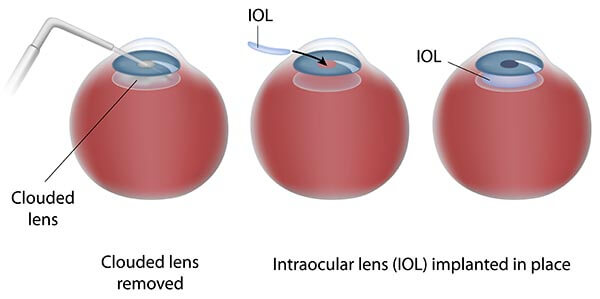Shaaf Eye Center is a premier destination for patients needing cataract removal and lens implant surgery. Our top-rated cataract surgeons, Dr. Mehdi Shaaf and Dr. Kevin Prendiville, have performed over 23,000 “no-needle and no stitch” cataract/lens implant surgeries and have gained recognition for their personalized approach to care. Using state-of-the-art equipment, the latest surgical techniques, and by offering a wide variety of advanced lens implant options, our team will partner with you to customize a treatment plan aimed at providing your clear vision to meet your unique lifestyle. Call us today to learn how our cataract surgery specialists can help you see clearer!
A cataract is a clouding of the normally clear lens of your eye. For people who have cataracts, seeing through cloudy lenses is a bit like looking through a frosty or fogged-up window. Clouded vision caused by cataracts can make it more difficult to read, drive a car (especially at night) or see the expression on a friend’s face. Most cataracts develop slowly and don’t disturb your eyesight early on. But with time, cataracts will eventually interfere with your vision.
At first, stronger lighting and eyeglasses can help you deal with cataracts. But if impaired vision interferes with your usual activities, you might need cataract surgery. Fortunately, cataract surgery is generally a safe, effective procedure.
Not all cataracts need treated Immediately. Cataract surgery is usually recommended for when a person experiences adverse visual effects from the cataract in the course of daily living. Simply put, when the cataract is interfering with daily activities.
Occasionally, cataract/lens implant surgery is performed for refractive purposes, only. Prior to cataract surgery, we perform measurements in our office and utilize advanced intraocular lens implant calculation formulas to ensure accuracy in the selection of power of the intraocular lens to be implanted. eyes.
Your surgeon replaces your cloudy lens with a monofocal IOL to restore basic focus to your eye, but you usually still rely on glasses for reading and close-up work.
In this surgery, your ophthalmologist not only replaces your lens and restores your vision, but also correct any significant refractive errors (nearsightedness, farsightedness, or astigmatism) to reduce or eliminate your dependence on corrective lenses. The latest generation of advanced multifocal lenses that enable you to focus at more than one distance and light adjustable lenses (LALs) which enable the visual to be customized with special light treatments following the surgery.
If you have astigmatism, this type of surgery replaces the cloudy natural lens with advanced toric IOLs to dramatically reduce your eyeglass prescription after surgery, enabling you to see at distance better. You have the option of eliminating glasses for all distances by undergoing custom cataract surgery followed by IntraLaseⓇ LASIK laser eye surgery.
The ophthalmologists at Shaaf Eye Center know that every patient has unique goals following cataract surgery. When you make the decision to have cataract surgery, one of the first things you will need to think about is the type of lens replacement you want. The cataracts experts at Shaaf Eye Center will help you determine which intraocular lens (IOL) will best suit your vision needs. The types of lenses offered at Shaaf Eye Center include:

Generally offered with traditional cataract surgery, monofocal lenses correct vision only at one portion of your visual range, usually distance.
Patients usually rely on glasses for reading and close-up work after surgery.
Considered an “advanced lens” multi-focal lenses correct a full range of vision issues, including nearsightedness, farsightedness, and problems in between. Patients selecting this lens restore more youthful vision and may not need glasses after surgery.
An intraocular lens such as the Crystalens® can flex or accommodate, using your eye’s natural muscles to focus on subjects at various distances, delivering a continuous range of vision. They can even correct age-related presbyopia, helping patients see at close range.
These intraocular lenses are designed for people with astigmatism.
Fun Fact:
In 1997, Dr. Prendiville was chosen by Staar Surgical to be the first ophthalmologist in Arizona to implant a toric intraocular lens for the correction of astigmatism.
Cataract surgery is typically performed under intravenous sedation with monitored anesthesia care and with powerful anesthetic eye drops and other agents to ensure comfort. This takes an average of 12 minutes or a little longer when combined with ORA and/or implantation of a glaucoma drainage device for pressure lowering in glaucoma patients. The incision is self-sealing and very small at 2.4 mm, thus resulting in no need for stitches.
No studies have proved how to prevent cataracts or slow the progression of cataracts. But doctors think several strategies may be helpful, including:
Have regular eye examinations. Eye examinations can help detect cataracts and other eye problems at their earliest stages.
Quit smoking. Ask your doctor for suggestions about how to stop smoking. Medications, counseling and other strategies are available to help you.
Manage other health problems. Follow your treatment plan if you have diabetes or other medical conditions that can increase your risk of cataracts.
Choose a healthy diet that includes plenty of fruits and vegetables. Adding a variety of colorful fruits and vegetables to your diet ensures that you’re getting many vitamins and nutrients.
Studies haven’t proved that antioxidants in pill form can prevent cataracts. But, a large population study recently showed that a healthy diet rich in vitamins and minerals was associated with a reduced risk of developing cataracts. Fruits and vegetables have many proven health benefits and are a safe way to increase the amount of minerals and vitamins in your diet.